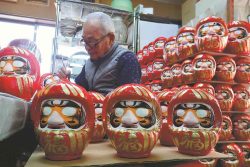10:57 JST, May 13, 2023
Conspiracy theories regarding the shooting death of former Prime Minister Shinzo Abe in Nara last July continue to circulate online. One recurring theme claims that Tetsuya Yamagami, 42, who has been indicted for murdering Abe, is not the true culprit. A video disclosing the name of a “suspicious” person at the shooting scene has also been spreading.
The Yomiuri Shimbun has been investigating what lies beneath these trends.
A video titled “The mastermind of the assassination has been identified” posted on YouTube has been viewed more than 100,000 times. Abe’s murder has featured in many other videos, depicting the ex-prime minister giving a speech, then loud gunshots and billows of white smoke. Many such videos remain on the internet.
The person who posted the “mastermind” video edited and incorporated such uploads, and repeatedly states that there was another shooter on top of a building near the scene.
Another widely spread video covering Yamagami’s alleged shooting says, “I checked the audio to find out it was blank shot.” These postings — characterized by such assertions as that Yamagami was a decoy, that the real shooter works for a foreign intelligence organization, and that police are hiding the truth — have received numerous positive comments.
One video treats as suspicious members of the public and local politicians filmed at the scene and discloses the name of one of the politicians, who is accused of collaborating with an intelligence organization and destroying evidence. The politician told The Yomiuri Shimbun that the accusations were “groundless and unforgivable.”
Speculation regarding the shooting began to spread on social media sites based on the fragmentary information provided immediately after the incident.
Following the gun attack, Abe, then 67, was taken to a hospital, where doctors held a press conference and explained the locations of the gunshot wounds in his neck. At that time, exact details were not known, as an autopsy had yet to be carried out. Questions began to spread on social media sites, including doubts over whether the wounds matched the direction from which the bullets had been fired.
But what prompted such large leaps in logic? In answer to this question, Yoshiaki Hashimoto, a professor of psychology and communication at Tokyo Woman’s Christian University, cited “cognitive distortion,” which is based on each person’s values and stereotypes.
When humans experience an event that stimulates such emotions as anger or sadness, and they feel some elements of the event are unclear or uncertain, they feel unsettled. To make up for the lack of certainty, they sometimes fashion extreme interpretations.
Following Abe’s death, his ties with the Family Federation for World Peace and Unification (formerly the Unification Church) came to light. Hashimoto said, “It’s possible that some of the people who did not like Abe being criticized were open to the idea that there were hidden truths.”
Information disclosure
Whether and how to disclose justice system-related information concerning serious incidents has also become an issue.
Conspiracy theories have arisen regarding historic incidents and accidents in the past. In the United States, many people still support the theory that the Central Intelligence Agency was involved in the assassination of President John F. Kennedy in 1963.
In Japan, some people strongly believe that there was a “real culprit” in a 1997 case in Kobe in which children were attacked and murdered. And some still think that a Japan Airlines jumbo jet that crashed in 1985 was shot down by the U.S. military.
The possibility of a third party’s involvement has already been ruled out in the case of Abe’s murder. According to investigators, analysis of security camera footage has verified that the bullets fired by the suspect hit Abe in the neck. A reproduction experiment using 3D video images has also been conducted and validated.
Such details, however, are rarely announced by investigative authorities prior to a trial on the grounds that it could hinder the investigation. The Nara prefectural police and the Nara District Public Prosecutor’s Office adopted this stance in the Abe case.
Even following the introduction of Japan’s lay-judge system, not all evidence is disclosed. Pre-trial proceedings to hammer out the main issues of each case and narrow down the evidence are usually closed to the public.
In the United States, it is not unusual for security camera footage and detailed investigation-related materials to be made public on websites and other media immediately after a criminal case occurs or after a suspect is indicted.
“Conspiracy theories are more likely to spread if facts remain confidential for a long period,” said Eiji Tsukahara, a lawyer familiar with information disclosure in the criminal justice system. “The risk of invoking distrust of judiciary authorities is increasing with the contemporary spread of social media.
“Balancing information disclosure against possible hindrances to investigations must be considered, but authorities should disclose the facts about major cases as much as possible — especially when a case could be a subject of national debate — and increase the transparency of the trial process,” Tsukahara added.
"Society" POPULAR ARTICLE
-

M4.9 Earthquake Hits Tokyo, Neighboring Prefectures
-

Israeli Tourists Refused Accommodation at Hotel in Japan’s Nagano Pref., Prompting Protest by Israeli Embassy and Probe by Prefecture
-

M7.5 Earthquake Hits Northern Japan; Tsunami Waves Observed in Hokkaido, Aomori and Iwate Prefectures
-

Tsukiji Market Urges Tourists to Avoid Visiting in Year-End
-

High School in Kyoto Says Students Shoplifted during Recent School Trip to Bali, Indonesia
JN ACCESS RANKING
-

Tokyo Economic Security Forum to Hold Inaugural Meeting Amid Tense Global Environment
-

Keidanren Chairman Yoshinobu Tsutsui Visits Kashiwazaki-Kariwa Nuclear Power Plant; Inspects New Emergency Safety System
-

Imports of Rare Earths from China Facing Delays, May Be Caused by Deterioration of Japan-China Relations
-

University of Tokyo Professor Discusses Japanese Economic Security in Interview Ahead of Forum
-

Japan Pulls out of Vietnam Nuclear Project, Complicating Hanoi’s Power Plans

























